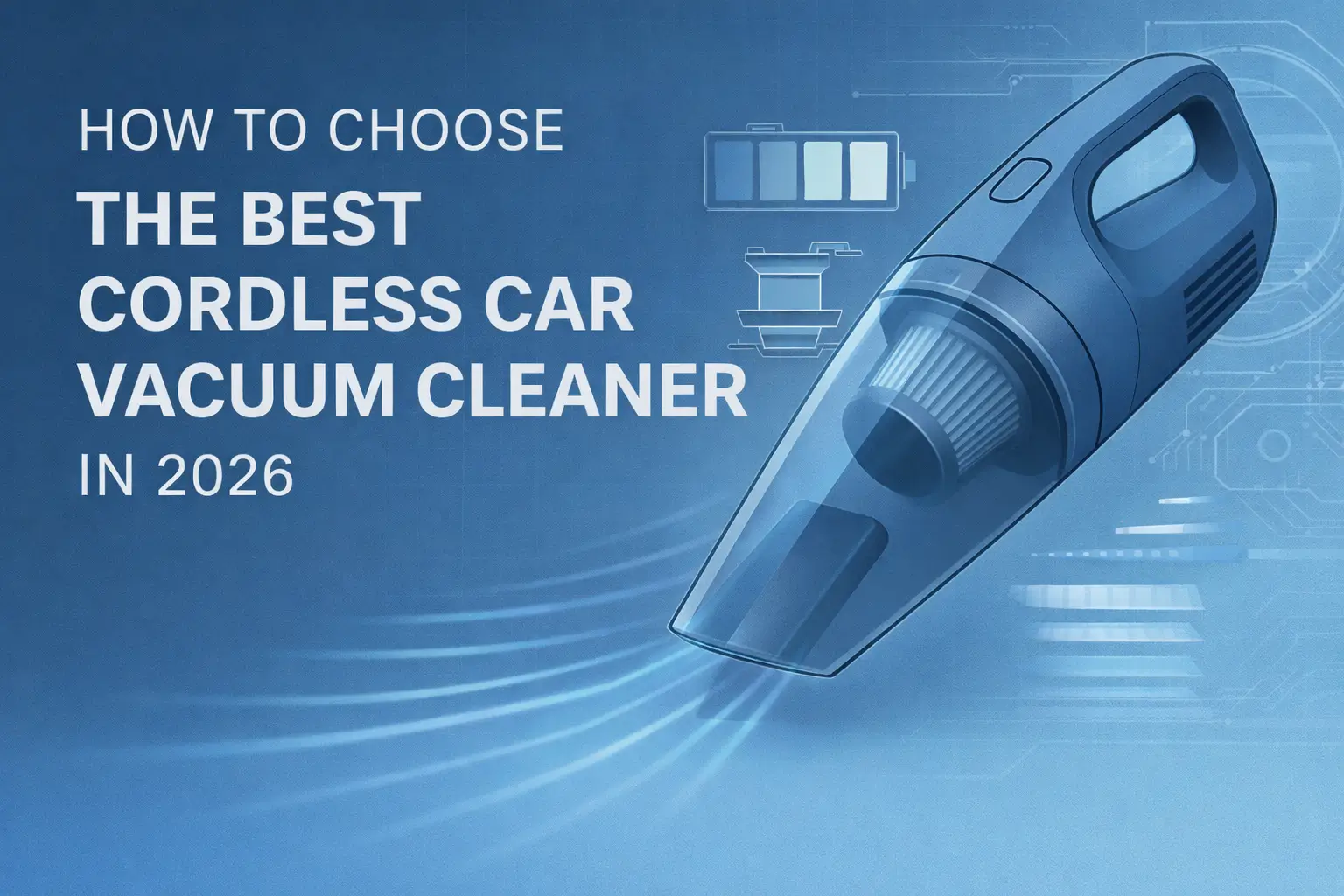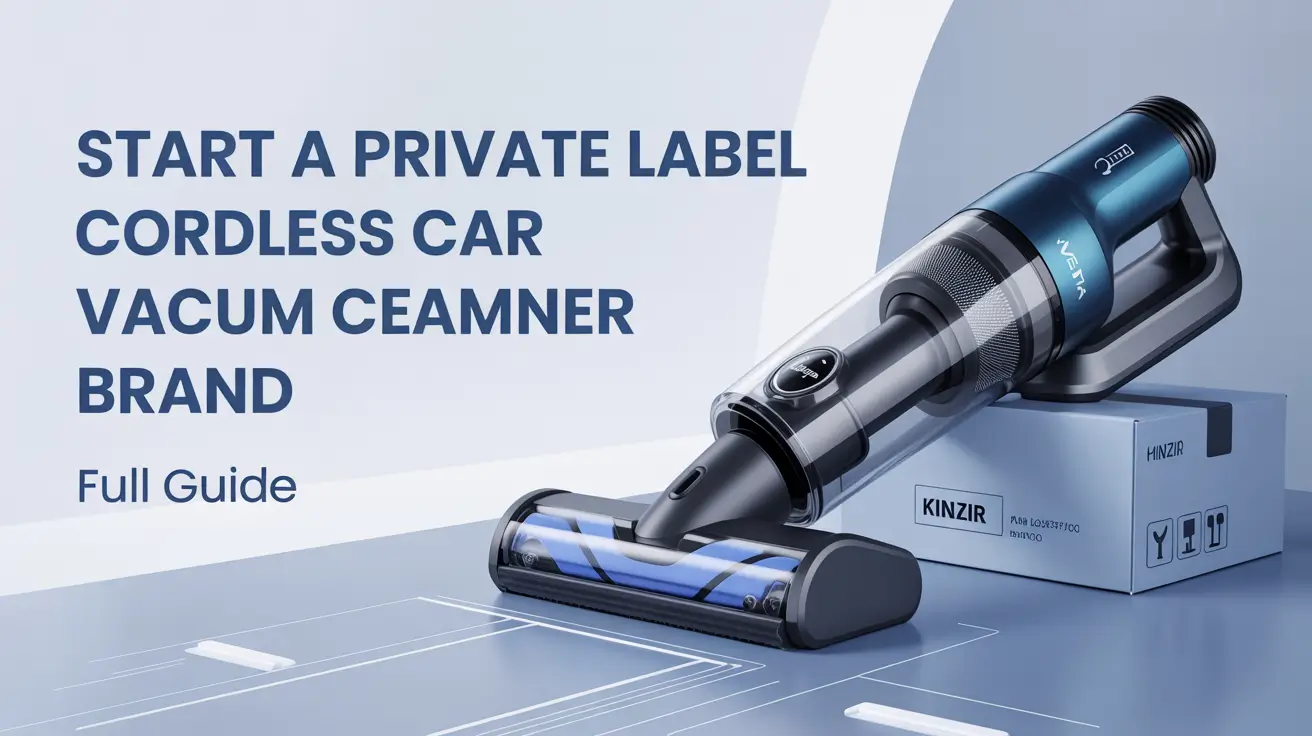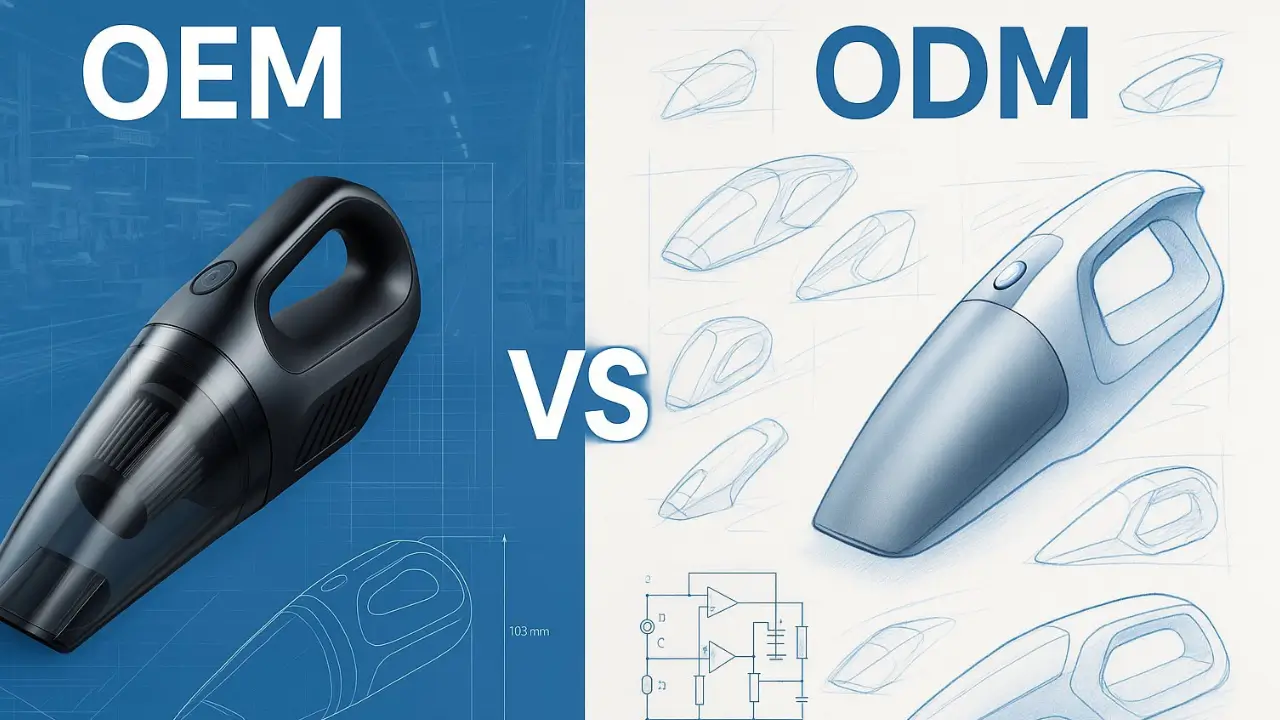Plenty of drivers find themselves wondering, “Is a Car Vacuum Cleaner Worth Buying?” especially when they’re tired of constantly running to the car wash. A car vacuum cleaner really is a smart move for folks who want fast, no-fuss interior cleaning without leaving the driveway.
Kinzir, one of the bigger names in the business, makes vacuums for cars, mini turbo jet fans, and electric dusters. They offer CBU and SKD export modes, and even handle OEM services for businesses, so there’s a bit of everything.
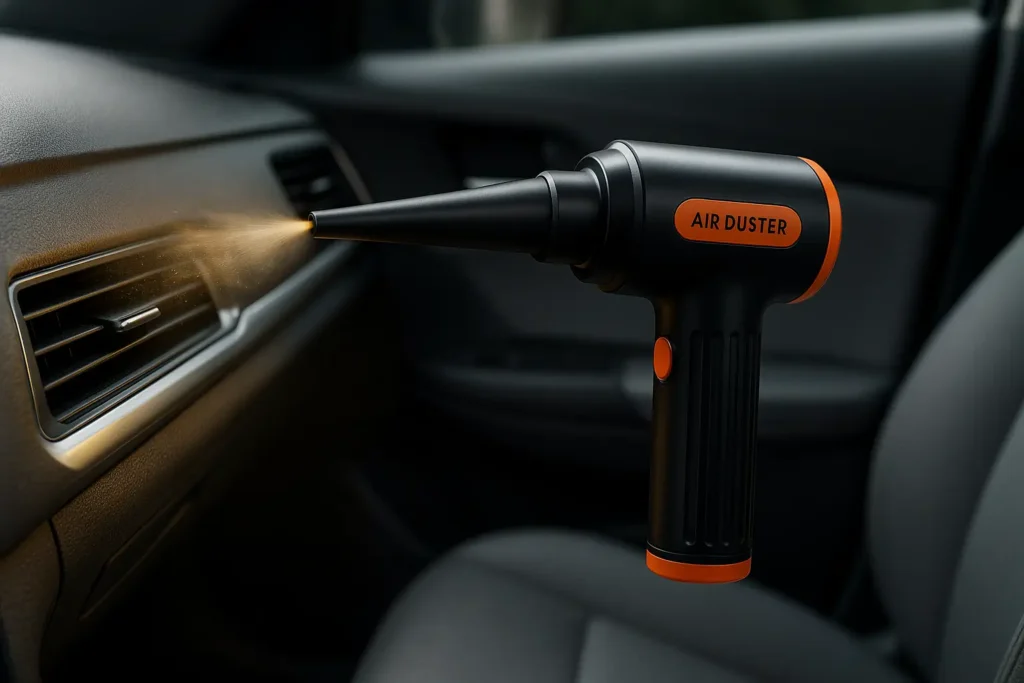
Car vacuum cleaners make it so much easier to stay on top of daily messes: pet hair, crumbs, dust, you name it. They can actually help extend the life of your car’s interior, and you barely have to break a sweat.
If you want to cut down on cleaning time and get results you just can’t manage with a regular household vacuum, a dedicated car vacuum is worth a look.
Choosing a vacuum made for cars is just practical if you care about a clean, comfy ride. These gadgets are everywhere, simple to use, and honestly, not a bad investment if you’re picky about keeping things tidy.
On-Demand Cleaning At Your Fingertips
It’s hard to beat the convenience of having a portable car vacuum on hand. You can attack spills and dirt the second they show up.
Dirt, crumbs, pet hair, dust: most cars collect this stuff faster than you expect. If you’ve got kids or pets, you know the struggle.
Lots of people swear by a handheld car vacuum. Models like the Armor All portable vacuum and Hoover Auto-Go get good reviews for being compact and easy to use.
Here’s a snapshot comparison of a few favorites:
| Model Name | Type | Can Handle Wet/Dry? | Power Source |
|---|---|---|---|
| Armor All Portable Vacuum | Handheld, Auto | Wet/Dry | 12V adapter |
| Hoover Auto-Go | Handheld (corded) | Dry | 12V adapter |
| Portable 12V Car Vacuum Review | Compact, Lightweight | Dry | 12V adapter |
Portable car vacuums are almost always lightweight. You’re way more likely to keep up with cleaning when you don’t have to drag out a shop vac or drive to a car wash.
If you just want to do quick touch-ups, these auto vacuum cleaners are a lifesaver. Most plug right into the car’s 12V outlet, so you don’t have to worry about charging batteries or hunting for an extension cord.
Some work better than others, honestly. If you want to handle both wet and dry messes, a wet/dry car vacuum might be your best bet.
Others might just want something small and easy for dust and crumbs. Either way, these little tools make it a lot less of a chore to keep your car looking decent.
Protecting Upholstery And Floor Mats
Cleaning your car’s upholstery and mats regularly does wonders for how your interior looks. Dust and crumbs have a way of working their way deep into fabric, and stains? They sneak up on you.
Using a car vacuum gets rid of dirt before it becomes a bigger headache. Pet owners, especially, know the pain: pet hair sticks to seats and carpet like glue.
A vacuum with good suction and the right attachments can actually pull hair and dander out of the fabric and those impossible crevices. It’s a relief if you’ve ever tried to use a lint roller on your back seat.
Routine vacuuming helps keep your upholstery and carpets in better shape for longer. When you get rid of sand and grit quickly, mats don’t wear out as fast.
What’s a car vacuum good for in upholstery care?
- Pulling up daily dirt and crumbs
- Grabbing pet hair and dander
- Getting into seams and tight corners
- Removing sand and tiny bits from mats
| Task | Regular Vacuum Cleaning |
|---|---|
| Dirt and crumb removal | ✔ |
| Pet hair extraction | ✔ |
| Stain prevention | ✔ |
| Maintaining fresh smell | ✔ |
| Slowing wear and tear | ✔ |
When seats and mats are clean, the car just feels nicer to drive. Plus, it’s easier to spot spills and fix them before they turn into permanent stains.
Key Features To Check
Picking out a car vacuum cleaner comes down to power, filtration, nozzles, and size. Little things: like filter type and attachments, can make a surprising difference.
Suction Power
Suction is probably the first thing to check. Models like the Dyson V7 Car+Boat have serious power: they’ll pick up sand, pet hair, even that gritty stuff that gets stuck in floor mats.
Power is usually listed in air watts (AW) or kilopascals (kPa), and bigger numbers usually mean better cleaning. Corded vacuums like the Black + Decker BDH1200AV can deliver steadier suction since they run off the car’s 12V outlet.
Cordless models are more portable, but sometimes you trade off run time or a bit of power, depending on the battery. For most people, at least 12-20 AW (or the equivalent) is a safe bet.
Some brands hype up “peak” power, but it’s the average you’ll notice. Strong suction means you’re not just brushing dirt around: it’s actually gone.
Filter Type
Filter type affects how clean your car really gets: and how the air smells after. HEPA filters catch fine dust, pollen, and allergens much better than basic ones.
Cyclonic filtration is nice too, since it keeps suction strong as the bin fills. Some vacuums have washable or reusable filters, which is a money-saver if you vacuum a lot of pet hair or fine debris.
Basic foam filters don’t catch tiny particles as well, but they’re easy to clean. It’s worth checking if replacements are easy to buy (and not expensive).
If you have allergies, look for a clear HEPA rating. Not every model is up front about it, and it makes a difference if you’re sensitive to dust.
Nozzle Designs And Attachments
The right attachments can make or break your cleaning routine. Look for a vacuum with a few different nozzles: crevice tools for tight spots, brushes for upholstery, and hoses for those weird corners under the seats.
The Dyson V7 Car+Boat, for example, is popular for all its attachments. It’s nice to have options, especially for leather seats or narrow gaps.
Table:
| Attachment Type | Best For |
|---|---|
| Crevice Tool | Between seats, tight seams |
| Brush Nozzle | Upholstery, vents |
| Extension Hose | Floorboards, under seats |
| Pet Hair Tool | Removing stubborn hair |
Having a kit with multiple nozzles means you can handle big crumbs, fine dust, and delicate surfaces without switching tools. Some cheaper vacuums only come with a basic nozzle, which can be limiting if you want a deep clean.
Size And Weight
Portability matters—a lot. Cleaning inside a car is awkward enough without lugging around a heavy vacuum.
Compact models fit in the trunk or glovebox, and lighter vacuums won’t tire you out as fast. Cordless ones are usually lighter, which helps if you’re cleaning often.
The Black + Decker BDH1200AV is a good example: small enough for tight spaces, but still gets the job done. Just make sure the vacuum isn’t too bulky to reach under seats or between cushions.
If you’ve got a bigger car (or it gets dirty fast), a larger dust bin might be worth the extra weight. Lightweight design, a comfy handle, and good balance all make cleaning a little less of a hassle—and honestly, that’s what you want.
Power Options: Corded Versus Cordless
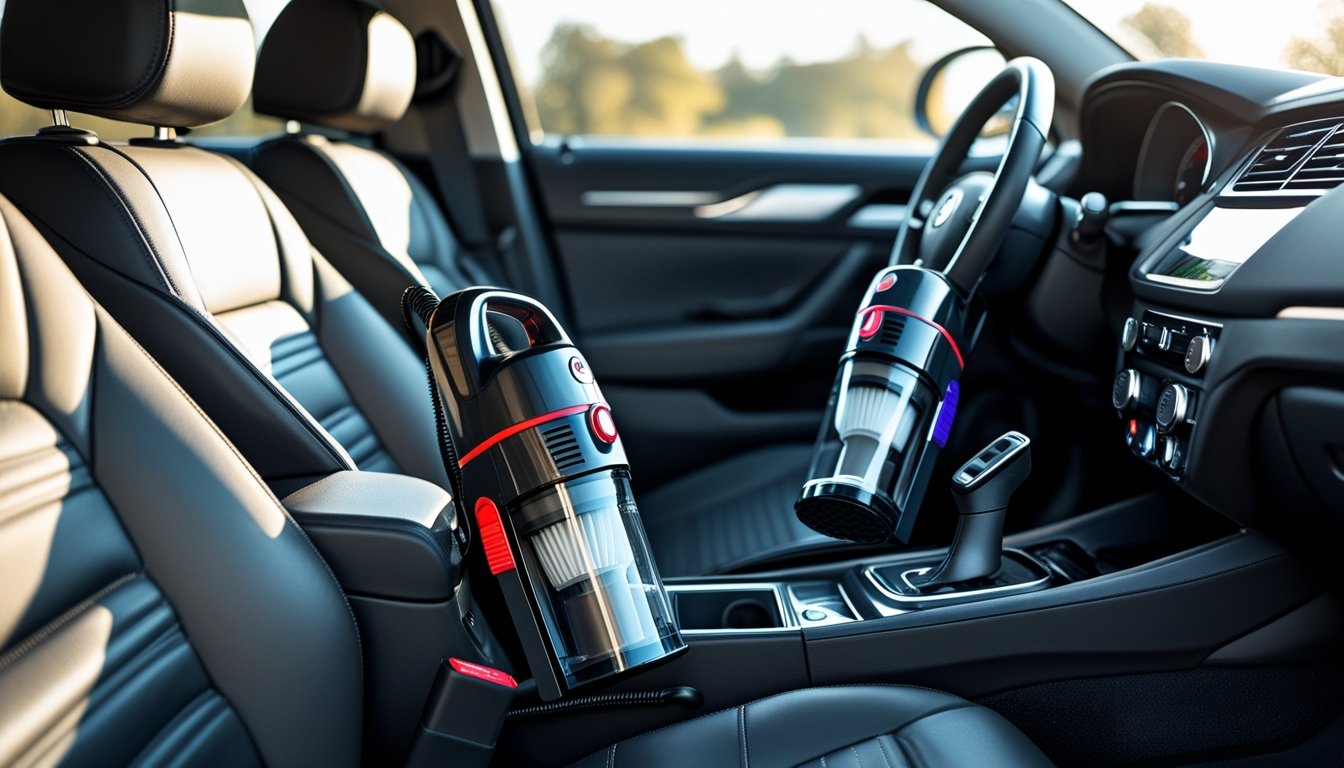
Car vacuum cleaners come in corded and cordless options. Corded models usually plug into a standard wall outlet or a car’s 12-volt power adapter.
Corded car vacuums can offer consistent power without worrying about battery life. They typically deliver stronger suction but require access to a power source and may have limited range due to the cord.
Cordless car vacuum cleaners run on rechargeable batteries. You’re free to move around, which is a relief in cramped car interiors.
Battery life and run time vary by model. The best cordless car vacuums may run for 15 to 45 minutes on a full charge, but maximum suction can drain that faster than you’d expect.
Here’s a simple comparison:
| Option | Power Source | Usability | Run Time |
|---|---|---|---|
| Corded | Plug-in (outlet/12V) | Limited range | Unlimited (in use) |
| Cordless | Rechargeable battery | Portable | 15–45 mins |
When choosing between corded and cordless car vacuums, it’s smart to think about where you’ll actually be cleaning most often. Power needs and battery life can really shape the experience.
Keeping Your Vacuum In Top Shape
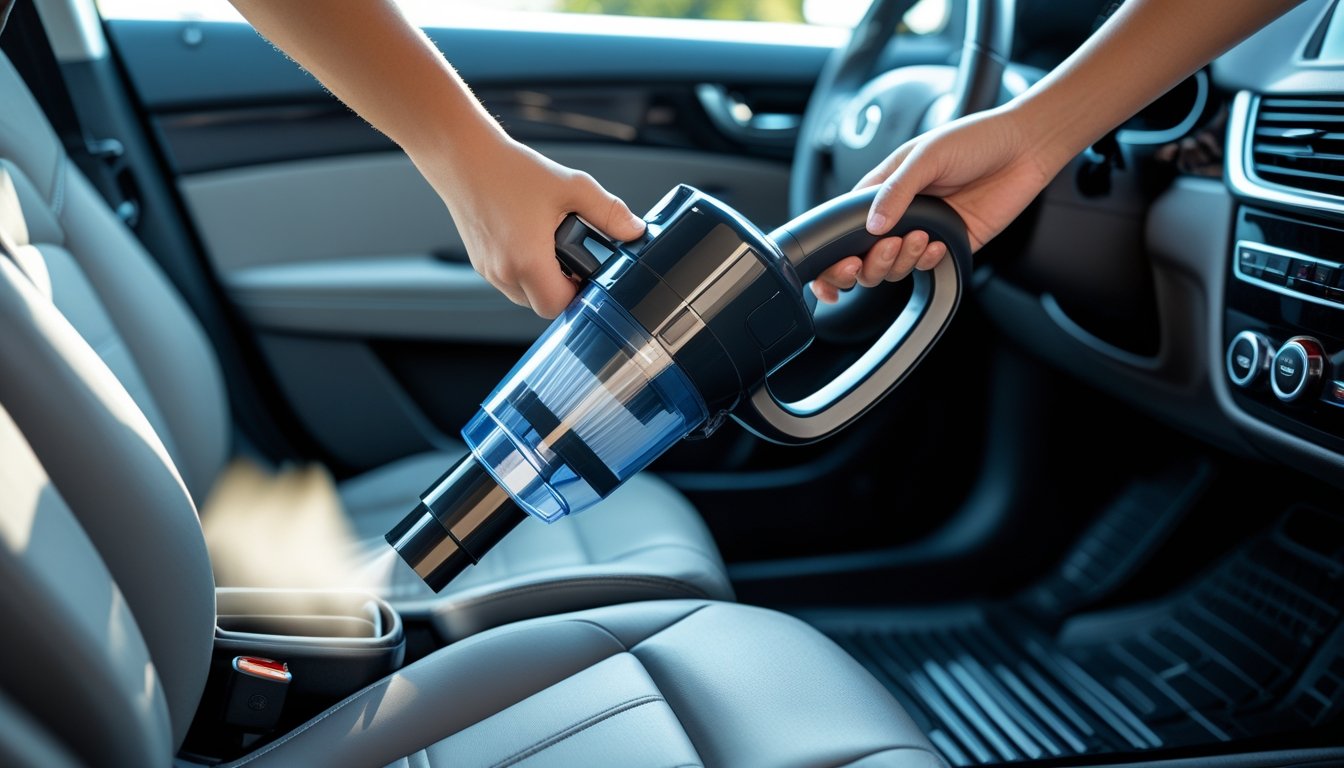
Proper maintenance of a car vacuum cleaner helps ensure long-lasting performance. Regularly cleaning or replacing the filter is essential, as a clogged filter reduces suction power and can affect the effectiveness of car interior maintenance.
Most filters can be rinsed or tapped clean every few uses. If the filter’s looking rough or still dirty after cleaning, just swap it out per the manufacturer’s suggestions.
Empty the dustbin after every cleaning session to prevent buildup and keep airflow moving. Wipe down the outside and attachments with a damp cloth to knock off dust and grime.
When you’re done, stash the vacuum and cleaning tools somewhere handy. Wall-mounted hooks, small bins, or car care boxes work surprisingly well for keeping accessories together without eating up trunk space.
A quick checklist for ongoing care:
- Clean or replace filter regularly
- Empty and sanitize dustbin
- Bundle cords or store batteries safely
- Keep attachments in one place
Investing in space-saving car care tools makes it easier to keep everything accessible. It’s not rocket science, but a little attention goes a long way toward keeping your vacuum running strong.
Cost Versus Long-Term Value
When considering a car vacuum cleaner, initial cost is often the first thing people notice. Most handheld models run between $30 and $150, depending on power, battery, and what’s in the box.
While the upfront expense might seem unnecessary, it’s worth looking at the cost versus benefit analysis over time. Regular use of a car vacuum can reduce the need for professional detailing, which typically ranges from $50 to $200 per session.
| Expense Type | Estimated Cost |
|---|---|
| Car Vacuum Cleaner | $30 – $150 (one-time) |
| Professional Cleaning | $50 – $200 (per use) |
If you’ve got kids, pets, or just a lot of mess in general, owning a vacuum can make life easier and maybe even keep your car’s value up. No more waiting for appointments—just a quick clean whenever you want.
Unlike disposable cleaning products, most car vacuums can be reused for years with minimal fuss—just empty the dustbin and rinse or swap the filter now and then. This long-term use really helps with cost efficiency.
It all depends on your habits, how you use your car, and whether you’ll actually keep up with maintenance. Some folks love the convenience, while others still prefer the occasional pro cleaning.
Why Choose Kinzir
Kinzir car vacuum cleaners emphasize strict manufacturing standards, robust performance, and buyer protection. These details give them a leg up over alternatives from Dyson, Shark, Bissell, Black+Decker, and ThisWorx.
ISO 9001:2015-Certified Quality Control
Kinzir follows ISO 9001:2015 for quality management. That means every vacuum’s made with consistent processes, so you’re less likely to get a dud.
Benefits:
- Ensures repeatable, high-quality results
- Reduces faulty units compared to brands that do not certify their production lines
- Promotes customer confidence in daily use
Dyson and Shark have solid reputations, but they don’t always mention ISO 9001:2015 compliance for every handheld. Kinzir makes that a baseline.
8-Hour Endurance And Insulation Tests
Before any Kinzir vacuum ships out, it goes through an 8-hour durability and insulation test. Basically, the motor runs nonstop to weed out weak parts or wiring issues.
Testing steps include:
- Continuous runtime at rated power
- Inspection for overheating or insulation breakdown
- Immediate disqualification for failed units
Other brands like Black+Decker or Bissell do quality checks, but Kinzir’s specific 8-hour protocol is rare. ThisWorx talks about testing, but not in this much detail.
12-Month Guarantee On Every Unit
Kinzir includes a standard 12-month guarantee with every vacuum. If something breaks or fails early, you’re covered.
What the guarantee covers:
- Malfunctions in the motor and electrical system
- Manufacturing defects in the casing, buttons, or attachments
- Replacement or repair with minimal paperwork
Dyson and Shark offer warranties too, but Kinzir’s 1-year coverage is consistent across all models. Black+Decker and Bissell sometimes change terms by region or product, so Kinzir’s promise feels a bit more straightforward.
Matching A Model To Your Driving Habits
Choosing the right car vacuum cleaner depends on how and where you drive. Daily commuters often deal with dust and crumbs, so a vacuum with decent suction and a portable design just makes sense.
Those with trucks, SUVs, or bigger vehicles might want larger dust bins and more versatile nozzles. Families with kids or pets? A model with pet hair attachments or extra car cleaning tools can be a lifesaver.
Frequent travelers could look for cordless models for convenience during road trips. Compact options are handy if you’re short on storage space.
Here’s a quick table comparing vacuum types based on different habits:
| Driver Type | Suggested Features | Accessory Needs |
|---|---|---|
| Daily Urban Driver | Lightweight, quick-charge | Basic car detailing tools |
| Family with Children | Strong suction, large dust bin | Pet hair/car cleaning kits |
| Off-Road Enthusiast | HEPA filters, rugged build | Automotive cleaning tools |
| Occasional User | Simple operation | Minimal accessories |
Matching a vacuum to your driving and vehicle use helps make sure it’s practical and actually gets the job done. Vehicle type and cleaning frequency matter, but don’t forget to check what detailing tools come with it and if they’ll fit in your car.
Frequently Asked Questions
Consumers compare car vacuum cleaners by features, performance, and overall value. Ease of use, cleaning results, and suitability for pet owners are common concerns.
What features should I look for in a high-quality car vacuum cleaner?
Key features include strong suction power, a range of nozzles and accessories, HEPA or advanced filtration, and a compact, lightweight design. Efficient cord management or cordless options increase usability in tight car interiors.
Washable filters and easy-to-empty dustbins can reduce ongoing maintenance. LED lights on the nozzle help find dirt in dark corners.
How does a cordless vacuum for cars compare to a corded model in terms of power and convenience?
Corded models usually offer stronger, steadier suction. Their range, though, is stuck at the length of the cord—which can get annoying fast.
Cordless vacuums make it so much easier to reach awkward spots in your car, especially if you’re parked far from an outlet. The freedom is nice, but you’ve got to keep an eye on battery life, particularly if you’re the type who likes a deep, thorough clean.
Batteries are getting better, so some cordless options can come pretty close to corded power—at least for quick jobs. Still, if you’re cleaning the whole car, you might need to recharge or swap batteries.
Are there any car vacuum cleaners that are particularly effective for pet hair and upholstery?
Yep, some vacuums are built with pet owners in mind. Attachments like rubber brushes or motorized rollers actually pull hair out of seats and carpets, which is a lifesaver if you’ve got a furry passenger.
Those compact nozzles are great for digging hair out of crevices where it likes to hide. Personally, I’d look for strong suction and a HEPA filter if you have allergies—no sense in just moving dust around.
Handheld wet/dry vacuums are also handy for pet messes. They’re not just for fur; they’ll tackle spills, too.
What are the advantages of using a dedicated car vacuum over a regular household vacuum?
Car vacuums are just made for the job. They’re slim, often with angled attachments, so you can get under seats or into door pockets without pulling a muscle.
Trying to wedge a big household vacuum into a car? Not fun. The bulkiness makes detail work nearly impossible.
Honestly, using a car-specific vacuum makes regular cleaning way less of a chore. And if you care about keeping your upholstery looking good, it’s probably worth having one around.
What do consumer reports say about the longevity and reliability of car vacuum cleaners?
It’s a bit of a mixed bag, according to consumer reports. Brand, build quality, and how well you maintain it all matter—no surprise there.
Vacuums with sturdy housings and parts you can swap out tend to stick around longer. Washable filters and easy-to-reach components get a lot of praise, too.
If you want your vacuum to last, empty the dustbin often and clean the filters. It might sound obvious, but a lot of people forget and then wonder why their vacuum bites the dust early.
Is it more cost-effective to purchase a professional-grade vacuum for car detailing?
Professional-grade vacuums come with a steeper price tag, but they’re designed to last and handle tough jobs. If you’re detailing cars all the time, or maybe juggling a few vehicles, investing in one might actually make sense down the road.
But for most folks just doing the occasional cleanup, a solid mid-range vacuum probably hits the sweet spot between price and performance. Honestly, keeping up with regular DIY cleaning at home can help you skip those pricey car wash visits and keep a few extra bucks in your pocket.

